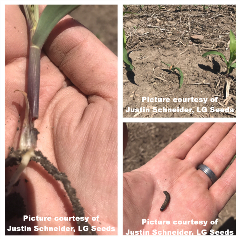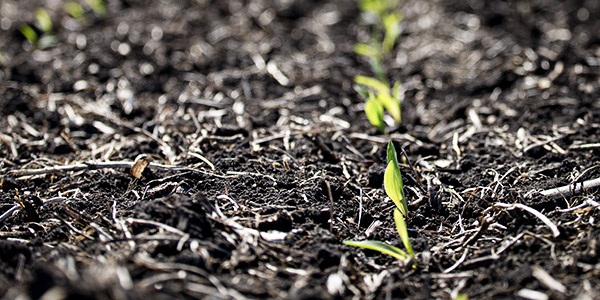AGRONOMICSUPPORT
YOU CAN TAKETO THE FIELD
Managing Black Cutworms
Black Cutworm moths are beginning to be detected throughout the Midwest. However, the moths themselves are not the concern – their larvae are. Black Cutworm larvae feed on, and kill, corn plants.
 Black Cutworm moths are dark in color and have a black ‘’dagger’’ on each front wing. To predict when the larvae will hatch, you must know the peak flight dates. There are a few trapping networks available that record and announce their numbers - find your local contact so you can be aware of peak flight dates in your area. Once you know this, add 300 GDD’s from the peak flight date to determine the range when you will need to be scouting your fields for feeding. When moths fly in, they will be attracted to weedy fields or no-till situations so they can have a green area to lay their eggs.
Black Cutworm moths are dark in color and have a black ‘’dagger’’ on each front wing. To predict when the larvae will hatch, you must know the peak flight dates. There are a few trapping networks available that record and announce their numbers - find your local contact so you can be aware of peak flight dates in your area. Once you know this, add 300 GDD’s from the peak flight date to determine the range when you will need to be scouting your fields for feeding. When moths fly in, they will be attracted to weedy fields or no-till situations so they can have a green area to lay their eggs.
The economic threshold for applying fungicide is when 3-5% of the plants show signs of feeding. There are plenty of insecticides that can be sprayed on fields to control the Black Cutworm. Larvae can generally be found next to a cut corn plant just below the soil surface.
 LG Seeds offers Bt corn traits to control Black Cutworm including Agrisure Viptera® trait stacks, Agrisure Duracade® trait stacks, Bayer’s Trecepta®, and Genuity® SmartStax®. If you planted a corn hybrid without Bt protection, it will be essential that you scout your fields when these larvae begin to appear.
LG Seeds offers Bt corn traits to control Black Cutworm including Agrisure Viptera® trait stacks, Agrisure Duracade® trait stacks, Bayer’s Trecepta®, and Genuity® SmartStax®. If you planted a corn hybrid without Bt protection, it will be essential that you scout your fields when these larvae begin to appear.
If you hear about moths being captured in your area, contact your local LG Seeds Technical Team Agronomist and they will help guide you in the right direction.
Download a copy of this technical bulletin here: Managing Black Cutworms
Sources and Additional Information:






Technical Team Agronomist